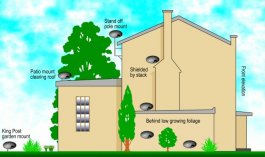Position satellite dish

A polar mount is designed to allow all visible geostationary satellites to be accessed by swinging the antenna around one axis (the main axis). This allows one positioner or actuator only to be used to remotely point the antenna at any satellite.
Polar mount installation involves pre-setting the two fixed angles shown here. The Main axis angle has a range of movement of approx 90 deg. The antenna swings sideways around this axis. The Dish Offset tilt angle is the amount by which the beam it tipped downwards slightly. This angle is less than 9 degrees. Both of these angles are predetermined exactly by calculation, but it is rarely possible to set the angles with sufficient accuracy (~0.2 deg) using scales and protractor. There is a tendency for dishes to sag somewhat and elevation angle scales may be inaccurate by 1 or 2 deg. Some minor adjustments are therefore necessary once satellites are being observed.
The main motor axis angle is the easiest to understand. It is the angle between the motor axis bearing line and the horizontal, in the nearest polar direction. i.e towards the north if you are north of the equator. If there is a main axis scale, the readings may be marked to correspond to this angle or alternatively to 90 minus the angle. Just see what happens when you set it to say 10 deg. If it does not result in the motor axis line sloping low down to the north then read the scale the other way. Set the scale to 80 instead. The angle is preset by calculation and careful adjustment and you can do this adjustment indoors at leisure till you understand clearly what is happening.
Setting the dish elevation is difficult. The easiest case is for an axi-symmetric dish, which has the LNB/Feed on the dish axis, in the middle, normally on three equal length legs. Just set the dish scale, if there is one, to minus 5 deg, for example.
More likely you have an offset dish. In this case you also probably have a motor with a cranked arm on it, typically bent 30 or 40 deg downwards. In this case if you set the dish scale to 30 or 40 the result is zero elevation. You want it set to Angle = 30 minus the small offset angle above. This means the dish is aimed 5 deg lower than a line at right angles to the polar axis. This will aim you correctly at the due south satellite, with the motor central.
The image above shows an axi-symmetric dish on the left and offset dish on the right. Follow the links below for further examples. If this is your first time, is won't be easy, and it may take a week or more.
Alignment objectives for a polar mount are:
The Main axis angle must be set exactly.
The Dish offset tilt angle must be set exactly.
The central position of the main axis rotation of the mount must accurately point due south (if you are north of the equator)
Set up procedure for polar mount:
An inclinometer (spirit level with scale or similar) is helpful. A plumb bob, i.e. fishing line and weight plus measuring rule and calculator or tan tables is an improvised alternative which can be quite accurate.
Check the ground fixed mount tube is exactly vertical. Apply the inclinometer in several places around the tube. All should read 90.0 deg. Adjust the mount tube if necessary and make sure all foundation bolts are tight.
Set the Main axis angle and the Dish Offset tilt angle as accurately as possible and set the moveable actuator to its middle position. The antenna now points to its highest elevation. If your dish is axi-symmetric (i.e. circular, with the feed in the middle) you can now check that the total elevation angle is correct. Measure elevation angle on the back of the hub of the dish; it should equal (90 - main angle - offset angle).
Related posts:

 How to make squash How to remote control desktop using lan tricks Tricks for keeping marks off your nose when wearing sunglasses Quickbooks help how to enter tips…
How to make squash How to remote control desktop using lan tricks Tricks for keeping marks off your nose when wearing sunglasses Quickbooks help how to enter tips… As both J.D. Power and Associates and Consumer Reports have noted, satellite enjoys a superior customer service rating among its multichannel competitors. Sustaining…
As both J.D. Power and Associates and Consumer Reports have noted, satellite enjoys a superior customer service rating among its multichannel competitors. Sustaining… What does tin stand for Tips on how to breed better dragons in dragonvale Linus tech tips how to build a pc what does negative mean what is capital murders mean…
What does tin stand for Tips on how to breed better dragons in dragonvale Linus tech tips how to build a pc what does negative mean what is capital murders mean… Simply activate the receiver through an existing DISH account or subscribe to a new Pay-As-You-Go programming package. Pathway X2 can point to either Western or…
Simply activate the receiver through an existing DISH account or subscribe to a new Pay-As-You-Go programming package. Pathway X2 can point to either Western or… A Dish Network digital video recorder (DVR) is controlled by a specialized remote that is provided with it. The Dish Network remote uses a code that allows it to…
A Dish Network digital video recorder (DVR) is controlled by a specialized remote that is provided with it. The Dish Network remote uses a code that allows it to…